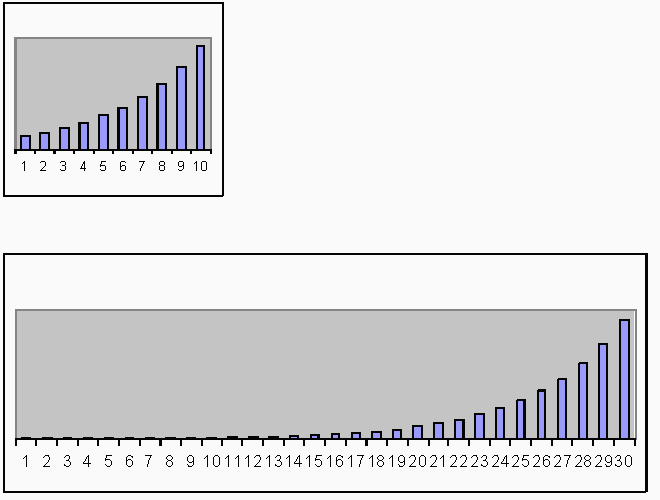2.a.2. Historical and human evolution
Changes of scale can affect a system’s particular objectives, and relevant variables may different from short-term and long-term variables. Likewise, internal dynamics in human and biological evolution can change according to the scale.
When speaking about the limits of knowledge, the temporal and spatial horizon may impede the logical reasoning when operating as the perception limits.
The perception of a dynamic system in the long-term would look like a film. The movie will give the effect of the internal dynamics, but not the proper internal dynamics.
Perhaps it is a typical effect of long-term models, that in many cases, the interest is on long-term dynamics regardless of their ultimate causes. You may also try to carry out a partial analysis because you cannot cover the entire problem.
The theory based on natural selection has its internal dynamics. However, it only refers to one of the evolution factors, which operates based on real development.
Since natural selection refers to the non-elimination of the better-adapted beings; it needs, on the one hand, to impose a random character on the rest of the possible conditions of biological evolution. On the other, for the long term to produce effects similar to those of real progression.
Information with an excellent presentation of the history of human evolution along the last 160.000 years and our ancestors' geographic routes are in Journey of humankind - The Peopling of the World. **
A long-term study of the history of humans implies a change of scale. Let us cite a summary of the problems arising to a greater or lesser extent:
There is a tendency to lose the temporal notion in the long-term analysis and the spatial context of a different scale from the human one.
Exponential growth perception 
Understanding the changes in relations between representative variables
The same problem can appear about the system’s internal relationships, the individual, and their particular objectives.
Not only can the variables change, but also they can alter their nature. For example, a discrete short-term variable may end being a continuous variable.
All alterations should explicitly appear when changing the spatial or temporal reference within a specific historical evolution analysis.
Genetics is on a different scale from the human body, and human evolution needs a long-term analysis.
The next graph shows how long-term analysis eliminates the perception of short-term changes. The figure displays an exponential growth whose ratio is 1.25, but by only triplicating the period, satisfactory visual outcome acts.
A human and a chimpanzee diverge by a little more than 1% of the genome, only ten times more than the very difference between two individual humans.
Estimating the genetic difference between humans and chimpanzees lies in no more than 400 million nucleotides (DNA elements) from 3 billion.
El País 20-02-2002 (The 1% could be slightly imprecise)
With the change of scale and despite exponential growth, we cannot stop thinking that, in the second figure, there is hardly any growth during the first 15 periods. It is worth noting that exponential growth is typical of temporal sequence models.
The ability to measure such small differences is lower when the intuitive scale corresponds to the latest period.
Some studies illustrate the limits of the human mind regarding the logical perception of variables and relationships. In other words, the conclusions could be fragile.
These considerations lead us to think about the implications of understanding only long-term human evolution and eliminating the short-term due to its little perception and sociological acceptance.
Let us quote some of the generally accepted facts of human history that are incorrect or could cause confusion with a misinterpretation:
The intellectual capacity of the Homo sapiens has not substantially changed during the last 30,000 – 50,000 years.
Making fire is a great evolutionary leap in human evolution, keeping in mind the first humans' cerebral capacity to achieve it.
Another significant milestone for their small intellectual capacity is the discovery of the wheel, indeed by accident.
Despite human mental capacity, we did not talk much or create large grammatical structures at the beginning of our species. Either it was not worth the time, or we had to wait for the vocal cords to develop through random mutations of the transmitted genetic information.
Scribes - Louvre Museum Egypt 2500 BC and 1450 BC 

In ancient Egypt, humans developed an excellent construction ability with the pyramids; managing the walls would not fall over for an extended period. There must be a reason they are the only ones of the seven wonders still standing!
-
Before the Greeks, scientific philosophy did not interest us, except for some honorable exceptions.
Some Greeks believed the practical application of knowledge meant reducing it and, therefore, should only stand in the world of ideas.
Romans technology allowed building aqueducts but not a closed pipe since they had not noticed some unknown weakness that water level tends to be the same. The seamen did not realize this despite the nooks where the land and water meet in many places.
Without knowing the exact origin, another tremendous Roman contribution was beginning to count with sticks, going so far, even representing five sticks with a V, which simplified mathematic calculi considerably.
-
The idea that the Earth was spherical was a little difficult to believe, especially given the moon and the Sun. The half-moon's shape was unknown, not seen anywhere else, even by aiming a light onto an orange in the dark. Finally, thanks to the accumulated knowledge transmitted from generation to generation, 500 years ago, the conviction was spherical and revolved around the Sun. Even though it may have gotten someone into trouble –Galileo (1564-1642), the reason could be a generational leap.
-
We were fortunate when it occurred to Newton (1642-1727). Thanks to his weakness for apples and the trend for thinking during his time, he expanded on his feebleness. He proved, amazingly, that something similar occurred to the Sun and the moon.
Miguel Servet (1511-1553) was not so lucky about his pulmonary circulation ideas and its role in respiration with the transformation of venous blood into arterial. Admittedly, he did not present them with the same poetic feeling as the apple of Newton.
-
There are no doubts about the long-term increase in human intellect, the different scales used to measure IQ –intelligent quotient– need to adjust every 20 to 25 years at most due to the Flynn effect.
Some authors estimate the IQ of some geniuses of humanity, adjusting the IQ to the corresponding era. It could be like double relativity! If there were a similar measure for height, it would turn out that Romans were as tall as Italians are nowadays. Admittedly, it will be another quantum effect of the relativity of space and time!
In short, examples are unlimited; on the other hand, we are sorry for having used a certain irony in these last points; we too have some weaknesses.
There is no attempt to diminish the contribution from those mentioned above; besides, it is quite the contrary since those advances make up part of human evolutionary history. They demonstrate the gradual improvement of the capacity of the human mind since the origin of man.
Going back to the usual seriousness and regarding the previous figures of exponential growth, the Homo sapiens have had 4,000 generations at most, according to the latest paleontological estimations. According to some authors, IQ shifts 10 points every 20 years, which means approximately 10 points every generation.
Found in Ethiopia, the oldest fossils -three skulls from 160,000 years ago
Given the small differences with the skulls of the current species, those responsible for the discovery are in favor of naming a new subspecies for these fossils; Homo Sapiens Idàltu, but specifying that by shape and size, they are very close to the Homo Sapiens (the current humans)
El País 12-06-2003 Nature
Advances in biology and genetics show genetic information changes in the short-term evolution, making classic approaches surpassed.
